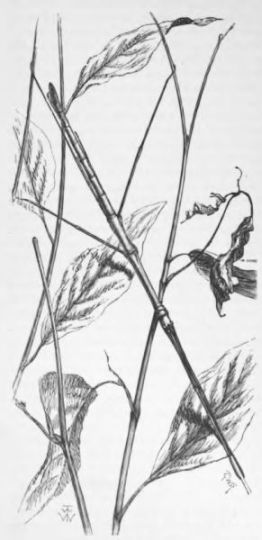|
Russel Wallace : Alfred Russell Wallace (sic)
A few years since a specimen of the Phyllium scythe, the "Walking Leaf" of India, was kept alive at the Royal Botanic Garden at Edinburgh. Mr. Andrew Murray wrote a long account of it, and among other matters says: "It so exactly resembled the leaf on which it fed, that when visitors were shown it, they usually, after looking carefully over the plant for a minute, declared that they could see no insect. It had then to be more minutely pointed out to them; and although seeing is notoriously said to be believing, it looked so absolutely the same as the leaves among which it rested, that this test would rarely satisfy [[p. 186]] them; and nothing would convince them that there was a real live insect there but the test of touch--it had to be stirred up to make it move, or taken off the plant to crawl on the finger of the attendant." But these remarkable insects do not stand alone. There are many others in every order which are "disguised" in a somewhat similar manner, some with equal perfection, others less accurately, but all serving the same purpose--that of protecting the insect from the enemies that would destroy it. I propose now to give a short account of some of the more interesting cases that occur both at home and in the more luxuriant regions of the tropics. Almost everyone must have noticed the very different way in which the bright colours are distributed in butterflies and moths. In the former, the whole upper surface of the wings is adorned with equally gay colours, while the under surface is always less brilliant, and is generally blotched or mottled with obscure or simple hues. In most moths, on the contrary, the bright colour is restricted to the upper surface of the lower wings, the upper wings being usually of variously mottled brown or ashy tints. This difference is at once seen to be connected with the habits of the insects, the conspicuous colours being so arranged as to be visible during flight, but hidden in repose. On the other hand, the beautiful mottlings and spots and delicate shadings that cause so many moths to resemble bark or lichens, or leaves or twigs, are never developed on those parts of the wings which are hidden during repose. Thus all the Bombycidæ and Noctuidæ, which conceal their hind wings when at rest, have them either quite plain or ornamented with rich orange or crimson hues; while almost all the Geometridæ, which rest with their wings spread open, and such of the Bombycidæ as have the same habit, are mottled and tinted alike on both front and hind wings. These general facts as to the distribution of colour constitute the first stage in that process of "disguise" which becomes so wonderfully developed in a few conspicuous cases. The next stage is exhibited by the fact that there is a general agreement between the colour of a large [[p. 187]] number of moths and the prevailing tints of nature at the season when they appear. Out of fifty-two autumn-flying moths, it has been noticed that a large proportion are of various tints of yellow and brown, so as exactly to match with the "sere and yellow leaf;" while in winter they are of grey and silvery tints, like the washed-out leaves and grass, the fog and the hoar-frost, which give a tone to every landscape at this season. We now come to a closer and more special disguise. Many of the moths that rest during the day on palings or on the trunks of trees are marked and coloured so as to 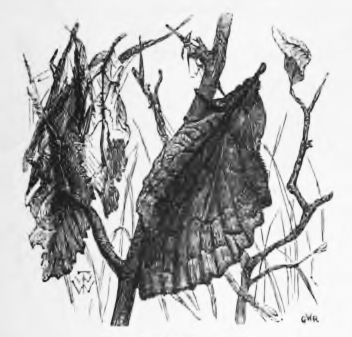
Fig. 44.--Lappet Moth. match the tints of the bark and lichens, and thus to escape observation. As examples of this numerous class, we may mention two of our commonest species--the "Dagger" (Acronycta psi) and the pretty green Agriopis aprilina. The Lappet moth (Gastropacha quercifolia) when at rest resembles very closely a small bunch of dead leaves; and at a little distance could hardly be taken to be a moth, so curiously does it spread out its hind wings so as to project beyond the others. The accompanying cut (Fig. 44) by the late Mr. T. W. Wood, is an accurate representation of this insect in its attitude of repose. [[p. 188]] One of the most curious of these resemblances is that of the Buff-tip moth (Pygæra bucephala). This insect closes its wings so as almost to form a cylinder; and on the tip of each wing is an oval yellowish spot, edged with a dark brown double line. The wings are greyish and hoary; and the head, again, is much contracted beneath the large thorax, which is also of a buff colour, with a double brown marginal line. The result of this arrangement is that the insect looks at first sight like a piece of 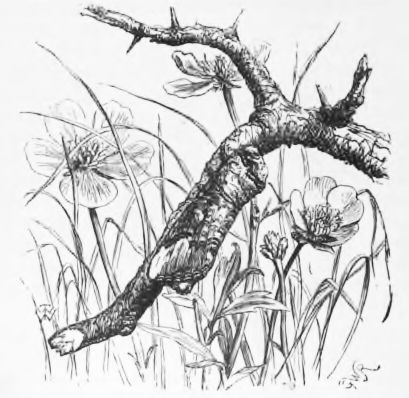
Fig. 45.--Buff-tip Moth. stick, one end being broken off nearly square, the other end more obliquely (Fig. 45); and as it often rests on the ground, among grass or on leaves, it may easily be mistaken for a piece of a broken branch which has fallen to the ground. Many more of these beautiful adaptations remain to be discovered in our native insects. That most elegant insect, the Elephant Hawk moth, is of a reddish-pink colour, mingled with dull yellowish-green, and with specks and streaks of white; but it has not been noticed [[p. 189]] how closely all these colours must assimilate it to the handsome red-flowered Willow-herb (Epilobium), on which the larva feeds, and on which the female insect, while depositing her eggs, no doubt often reposes. The petals of the common Epilobium angustifolium, for instance, are of the same pinky-red as the moth; its stems and seed-pods are green, tinted with brown-purple or yellowish, while the white filaments of its stamens correspond to the white lines and streaks of the insect. It is evident, therefore, that while reposing amid a clump of these plants, the Elephant Hawk-moth, although so brilliantly coloured, must be exceedingly difficult to detect, since every part of its body is of exactly the same hue as some portion of the flowers. We owe the discovery of one of the most beautiful examples of "disguise" in a native insect to the talented young artist and close observer of nature who furnished the illustrations for this chapter. He tells us that one fine afternoon in May, being overtaken by a shower, he sought shelter under a hedge, where, among other flowers, the wild parsley (Anthriscus sylvestris) grew in the greatest profusion. While observing the light and elegant forms of these plants, he noticed what appeared to be a small bunch of flowers projecting beyond the rest; and a closer examination led him to the interesting discovery that our beautiful little "Orange-tip," one of the gayest and brightest of our native butterflies, was reposing among these flowers in such a manner as to gain a complete protection by its resemblance to them. He was now able to see the use of almost every detail, both of the form and colouring of this insect. The bright orange patch, so beautiful when the insect is on the wing, was hidden beneath the hind wings; and there is thus a very good reason for the circumstance that the colour does not extend so far on the under as on the upper surface of the wing, and also for the tip of the upper wings being mottled with green beneath, like the whole surface of the hind wings; for as they are a little longer than the hind wings, the whole form one uniformly coloured surface when the [[p. 190]] wings are closed (Fig. 46). Various other species of Anthocharis, as well as the pretty Zegris of Eastern Europe and our rare Pieris daplidice, are coloured in a 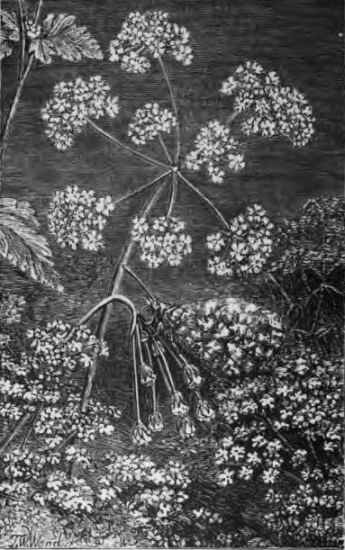
Fig. 46.--Orange-Tip Butterfly. similar manner on the under side, though with varying degrees of brilliancy; and it is probable that they are accustomed to repose on the flowers of umbelliferous or cruciferous plants of suitable colours. One of the [[p. 191]] handsomest species of Indian Pieridæ, the Iphias glaucippe, whose upper wings are ornamented above with a large patch of vivid orange-red, is so tinted and mottled on the under side as to resemble a dry leaf; and a strong dark line running through the centre of the wings represents the midrib. This species often rests on the ground, on the banks of streams or on beds of gravel, and depresses the upper wings so much between the lower ones as to form an outline very similar to that of a leaf; and this is no doubt a great protection to it; for although so large and showy an insect, it is very plentiful. By far the most singular and most perfect disguise I have ever met with in a Lepidopterous insect is that of a common Indian butterfly, Kallima inachis, and its Malayan ally Kallima paralekta. I had the satisfaction of observing the habits of the latter in Sumatra, where it is rather plentiful at the end of the dry season. It is a large and showy insect when on the wing, the upper surface being glossed with blue and purple, and the fore wings crossed obliquely by a broad band of rich orange. The under surface of the wings is totally different, and is seen at a glance to resemble a dead leaf. The hind wings terminate in a little tail, which forms the stalk of the leaf, and from this to the apex is a slightly curved dark brown line representing the midrib. The transverse striæ which cross the discoidal cell in many butterflies are here continued so as to form lateral veins, and the usual submarginal striæ on the hind wings, slightly modified, represent others towards the base of the wing. But it is only when the habits of the insect are observed that the disguise becomes manifested in all its perfection (Fig. 47). This butterfly, like many others, has the habit of resting only upon a nearly vertical twig or branch, with the wings closed together so as completely to conceal the upper surface. In this position, the little tail of the hind wings exactly touches the branch, and we now see why it is always curved inwards a little; for if it were quite straight, it would hang clear of the branch, and thus fail to represent an attached leaf. There is a little scallop or hollow on the margin of the fore wings at the base, which serves [[p. 192]] to conceal the head of the butterfly, which is very small for its size, and the long antennæ are carried back and 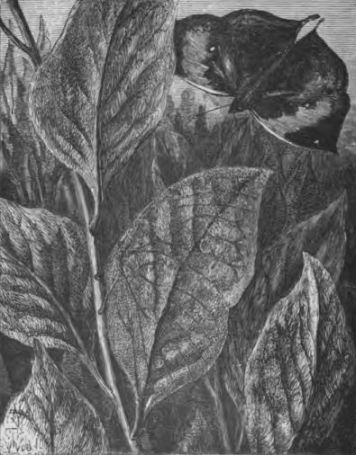
Fig. 47.--Leaf Butterflies at Rest and Flying. hidden between the folded wings. When sitting on a twig in the manner described, the insect is to all appearance a perfect dry leaf,--yet it is evident that its chances of [[p. 193]] escape would be much increased if it were surrounded by real dry leaves instead of by green ones; for if, when pursued, it took shelter in a growing bush, it could hardly fail to be still a conspicuous object. Marvellous to relate, it does possess the habit of almost invariably entering a bush loaded with dead leaves, and is so instantly lost to sight, owing to its close resemblance to all the surrounding objects, that I doubt if the most vigilant fly-catcher could detect it. I have myself often been utterly puzzled. I have watched it settle, apparently in a very conspicuous situation, a few yards off, but on crawling carefully up to the spot have been quite unable to detect any living thing. Sometimes, while gazing intently, a butterfly would start out from just before my eyes, and again enter another dead bush a few yards off, again to be lost in the same manner. Once or twice only was I able to detect it sitting, and admire the wonderful disguise which a most strange combination of colour, form, and habits enabled it instantaneously to assume. But there is yet another peculiarity which adds to the concealment of this species. Scarcely two of the specimens are alike in colour on the under side, but vary through all the shades of pale buff, yellow, brown, and deep rusty orange which dried leaves assume. Others are speckled over with little black dots like mildewed leaves, or have clusters of spots or irregular blotches, like the minute fungi that attack dead leaves; so that a dozen of these insects might settle on a perfectly bare spray, and clothe it at once with withered foliage not distinguishable from that of the surrounding branches! The protection derived from a vegetable disguise is not confined to the perfect Lepidoptera, but is often equally remarkable in their larvæ. The caterpillar of a European moth that feeds on the privet (Hadena ligustri) is so exactly the colour of the under side of the leaf, on which it sits in the day-time, that you may have the leaf in your hand and yet not discover it. In the caterpillars of the Geometridæ, form, colour, and habit combine to disguise many of the species. Those of the Brimstone and Swallow-tail moths may be taken as examples. They have the [[p. 194]] habit of stretching themselves out obliquely when in repose, attached only by the clasping legs at the further extremity, and will remain stiff and motionless in this position for hours. The little protuberances on the body, their colour and attitude, give them so exactly the appearance of twigs of the living tree, that we may easily conceive the advantage this disguise must be to them; for it is certain that many will escape destruction when more conspicuous insects will be devoured. Among the extensive group of the Coleoptera, the examples of a protective disguise are literally innumerable. In the tropics, every fallen tree swarms with beetles, and a large number of these so closely resemble the bark to which they cling, that it requires a close examination to detect them. The families of the Longicorns and Curculios furnish the greater part of these; and among the former, that which wears perhaps the most perfect disguise is the Onychocerus scorpio. This beetle is common in South America, and was found abundantly by Mr. Bates on the banks of the Amazon, but always clinging to the rough bark of one kind of tree, called by the natives Tapiribà. This bark was so closely imitated by the beetle itself,--its elytra and thorax being tubercled and coloured so as exactly to match it, and the insect clinging so closely as to form, apparently, one surface with the tree, that Mr. Bates assures me it was often absolutely impossible to detect it by the closest inspection as long as it remained motionless! Many of the Tiger beetles, although they are such conspicuous and beautiful objects in our cabinets, are well disguised when in their natural stations. Our commonest species, Cicindela campestris, is fond of grassy banks, where its green colour makes it difficult to see it. Cicindela maritima is almost exactly the same colour as the sandy shores it haunts. The large Cicindela heros frequents the mountainous forests of Celebes, where its brown colour exactly matches with the dead leaves that cover the ground. The magnificent velvety-green Cicindela gloriosa was captured only on wet moss-covered rocks in the bed of a mountain torrent in the island of Celebes, where it [[p. 195]] was very difficult to see it. The pale-coloured Cicindela Durvillei was found on coral sand of almost exactly its own colour; and I noticed generally that, whatever the colour of the sand or the soil, the common Tiger beetles of the locality were of the same hue. A most remarkable instance of this was a species which I found only on the glistening, slimy mud of salt marshes, the colour and shine of which it matched so exactly that at a few yards' distance I could only detect it by the shadow it cast when the sun shone! Several Buprestidæ of the genus Corœbus resemble the dung of birds freshly dropped on leaves, and I have often been puzzled to determine whether what I saw was worth picking up or not. Mr. Bates tells us that Chlamys pilula cannot be distinguished from the dung of caterpillars. Our own Onthophilus sulcatus is very like the seed of an umbelliferous plant, and the common Pill beetle (Byrrhus pilula) would be taken for anything rather than an insect. We must now turn to the Orthopterous insects, which contain some of the most surprising cases of disguise yet discovered. The true Walking Leaf has been already described at the commencement of this chapter, but there are other insects of a quite different structure which almost equally resemble leaves, as shown by the names given to them by the old writers; such as Locusta citrifolia, L. laurifolia, L. myrtifolia, &c. Acrydium gallinaceum, from the Malay Archipelago, has an immense erect leaf-like thorax; A. platypterum has wings like the most beautiful smooth green leaves; while A. gibbosum is like a little shapeless lump of mud or stick. The voracious Mantidæ are often concealed in a similar manner. Many have the thorax broadly dilated, and, with the wing-covers, coloured like a dead or a green leaf; and one has large brown legs and small wings, so that it looks more like a cluster of bits of stick and withered leaves than a living insect. The true Phasmidæ, or Stick-insects, are the most curious, perhaps, of all, and they are much more abundant in the eastern forests than the Leaf-insects. They vary from a few inches to a foot long, and are almost always of the colour and shape of pieces of stick, the legs forming
Fig. 48.--Stick Insect. the branches. One of the most curious facts connected with them is that they seem to know that if they rested in the symmetrical attitudes in which they are always drawn, with their legs spread out uniformly on each side, they would soon be detected. They are accordingly found stretched out motionless in the most unsymmetrical manner possible--one leg out on one side, and two on the other, for example, the remaining legs fitting so closely to the body that they appear to form one piece with it. [[p. 197]] They lay generally across leaves and twigs, as if they had accidentally fallen there from some dry branch overhead; and so impossible is it to detect them by the eye that I used to make it a practice, when walking along in the forests, to touch every suspicious bit of dead stick I saw loose on the foliage, as the only means of finding out whether they were real sticks or Stick-insects. Sometimes they are exactly the colour of lichen-covered branches, and are covered with little foliaceous expansions. One that inhabits the swampy forests of Borneo has these of a beautiful olive-green colour, so as exactly to resemble a creeping moss or jungermannia; and the Dyak who brought it me assured me it was very curious, for he had never before seen an insect grown all over with moss while alive! I was quite as much astonished as he was, for I could hardly believe my eyes, and it was only after close and repeated examination that I could convince myself it was not a real plant that covered the animal. This insect loses all its beauty when dried, and it has been very poorly figured by the Dutch naturalists, and very inappropriately named Ceroxylus laceratus, from its torn and shaggy appearance in the preserved specimens. In the deserts of Egypt are some curious Mantidæ which are so exactly the colour of the soil they live upon that the closest inspection can scarcely detect them. It is even stated that where the soil changes from brown to white or yellow in a few yards' distance, the insects change also, and always correspond in colour to their habitation. The caterpillar of a European moth, Bryophila algæ, is said to change in a similar manner, being yellow when found on the yellow Lichen juniperinus, but grey when on the grey Lichen saxatilis. In this case, however, the food may probably produce the change of colour, as it is known to do in some other larvæ. Some cases more to the point have been observed by the late Mr. T. W. Wood. He states that the chrysalis of the common Tortoise-shell butterfly is of a very different colour according to its position. When attached to a nettle, it is of a golden colour; when on a wall or fence, mottled grey; and when on a tarred paling, nearly black. Once he placed some [[p. 198]] larvæ of the Swallow-tailed butterfly in chip boxes, where they changed into chrysalids; but, strange to say, instead of being green or dusky, as they usually are, they were of exactly the same colour as the inside of the box, without any marking whatever. Some of them produced very fine butterflies, which shows that they were healthy.1 These curious facts prove that we have yet much to learn as to the causes which determine the colours of animals, and it is to be wished that a few of our young naturalists would experiment on some of our commonest insects, rearing them from the egg exposed to the influence of differently coloured objects and carefully registering the result. In this chapter I have only desired to call attention to some curious facts in the colouring of insects, and more especially to the disguises which serve to protect them from their enemies, or enable them more easily to entrap their prey. Such of my readers as may wish to know more of this subject, and may desire to learn how these strange modifications of form and colour have probably arisen, are referred to in Chapter III. of my Natural Selection and Tropical Nature, in which the most recent views of Mr. Darwin's disciples are fully explained.
1. Since the present chapter was written this subject has been well investigated by Prof. E. B. Poulton and other entomologists. See his book on The Colours of Animals, Chaps. VIII. and IX. [[on p. 198]]
|

